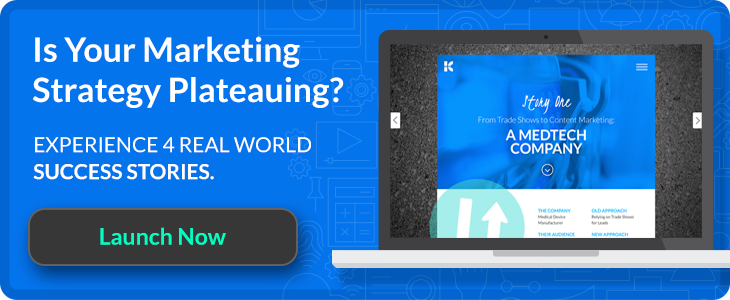
Use Patient Search Data to Craft Effective Healthcare Content
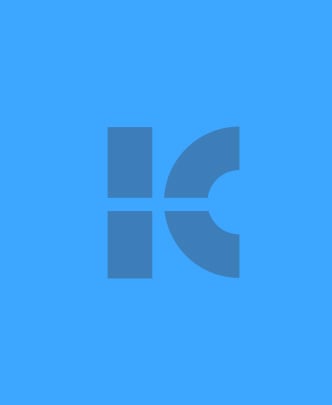
 Marketers have always had the goal of getting inside the heads of the people we’re working to reach. Part of the job is trying to figure out what our audience is thinking, what they want to know, and what they’ll respond to. For a long time, marketers had to depend on a mix of conjecture and the limited access they had to customers to try to understand audience behavior. Now we have a significant amount of data we can turn to for the information.
Marketers have always had the goal of getting inside the heads of the people we’re working to reach. Part of the job is trying to figure out what our audience is thinking, what they want to know, and what they’ll respond to. For a long time, marketers had to depend on a mix of conjecture and the limited access they had to customers to try to understand audience behavior. Now we have a significant amount of data we can turn to for the information.
Data has a lot to tell us about what people typically do when faced with a healthcare issue and how they go about picking their physicians. With the insights you glean from the data available, you can better shape your marketing to ensure you’re reaching customers where they are.
Your Patients Are Using Google
Like it or not, when patients have a healthcare concern most of them turn first to Dr. Google. Seventy-seven percent of people in the United States have said they’ve gone straight to a search engine when looking for health-related information. Astonishingly, one out of every 20 searches made in Google are for health information. When you think about the frequency with which people turn to Google, that amounts to a truly staggering number of searches.
A search engine will never be as good at providing patients with the proper diagnosis and treatment options as a trained physician, but it can provide some starter information on their symptoms that helps them gain an idea of what they’re dealing with. And you can do your part to make sure that some of the information out there is accurate and helpfully points people to your hospital.
As you likely already know, making sure your content is easy to find in Google is far more complicated than simply creating content that’s accurate and useful and then pressing publish (although those are all requirements). SEO requires a lot of work, but now that you know what the data has to say about how frequently your prospective patients are turning to Google, you know that it should be treated as an important component in your healthcare content marketing.
Find Out What Patients Are Searching For
Now that we’ve established that patients are frequently turning to Google, that begs the next question: What exactly are they looking for? When you have data on healthcare questions and topics people are searching for, then you’ll know exactly what topics to cover in your content marketing.
General Patient Search Data
Google has released information on the top nine most common healthcare searches:
- Is bronchitis contagious?
- Is pneumonia contagious?
- How much water should I drink?
- How many calories should I eat?
- What is lupus?
- How far along am I?
- When do you ovulate?
- What is gluten?
- How long does the flu last?
While it is valuable to know what the most popular searches are, keep in mind that their popularity makes these some of the hardest search terms to rank for. Nonetheless, they can help you shape content that may be underrepresented and still relevant to what people are looking for.
An article that provides a simple answer to “what is lupus?” probably won’t make it high into the search results, but you could also create a much more thorough guide for patients and their family members that tackles everything a lupus patient should know. Or you could break all that information down into a series of different types of content that covers everything related to the disease. A blog post that talks about the common side effects for different lupus treatments, for instance, or a video series that tackles common questions one by one.
Often the best way to provide content that cuts through the noise is to home in on a particular angle that hasn’t been covered as fully. Use the most common searches as a starting point to go digging for related information that isn’t as heavily covered on the Web.
Use Google AdWords Keyword Planner
Knowing what a broad range of patients is searching for is helpful for many large hospitals, but knowing what your patients and visitors are searching for is even more useful.
If you work for a practice focused on a particular specialty, then the most popular search terms across the board won’t help much; you need to know the most common search terms that relate to the care your practice provides. To do that, you can use the Google AdWords Keyword Planner to learn which terms people are searching for the most often.
While the Keyword Planner is designed specifically to help advertisers on the AdWords platform, it can also provide a lot of helpful information and insights for hospitals looking to use it for topic generation and SEO keyword research. If you plug in your specialty, your website and your city, the tool will provide you with:
- A list of relevant keywords divided into a few key topic areas (their “ad groups”)

- The number of average monthly searches for each keyword, so you know how often people are looking for them
- How competitive those terms are in your area, so you have an idea of how many other practices in your specialty are competing on those topics
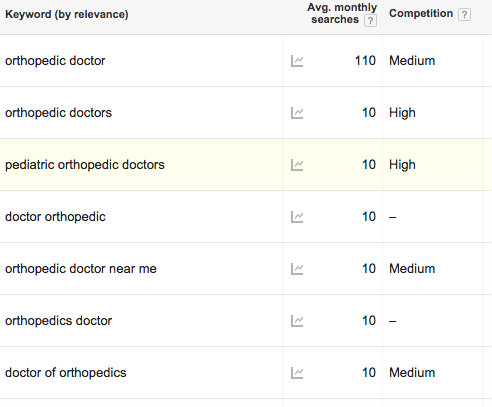
With these suggestions, you should be able to gain a fairly comprehensive list of topics and keywords related to the work your practice performs. If you work at a hospital with multiple specialties, simply repeat the process for each.
Keep in mind though, as with the most popular healthcare searches, these keywords are the same ones your competitors are pulling out of Google. If you let the keywords from Google’s tool be the end of your topic research, you’ll have a hard time breaking through the noise. Instead, treat your list of keywords as a starting point to understand your audience better, and then dig deeper.
If you plug some of your most popular terms into faqfox and choose the medical category, you’ll end up with a list of specific questions and issues people are asking related to that topic.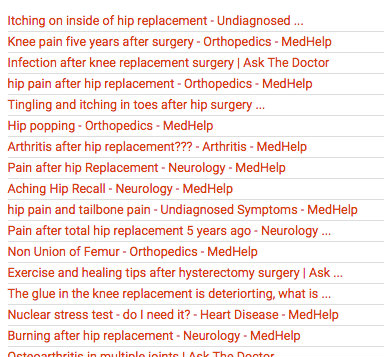
Instead of the broad “hip replacement,” you can focus on a question like “how to alleviate itching after a hip replacement?”
With keywordtool.io, you can see what the most common autocomplete options are for your popular keywords, so a “hip replacement” search nets you useful content topics like “hip replacement recovery time” and “hip replacement exercises.”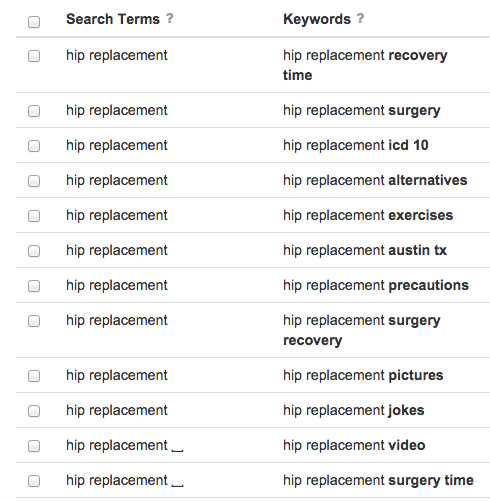
The keywords can be your starting point to figuring out a wide range of useful subtopics your prospects are out there wondering about.
Use Google Analytics
Google Analytics is a free tool most business websites already have set up, but few use to its full potential. The wealth of information that’s already available to you in Google Analytics can provide you with lots of insights into who your site visitors are, how they interact with your website, and what they’re looking for.
To start, look to see how people are finding your website now. The Acquisition section of your Google Analytics dashboard will let you know how people are making their way to your site. The direct traffic is coming from people who already know your brand. The more interesting insights will come from looking into the referral, organic and social sources.
- Referral: This will include any websites that link to yours, so this is where you’ll see if a lot of your potential patients are finding you on review sites, health insurance sites or from third-party coverage like news articles or hospital rankings.
- Organic: If you’ve been investing in SEO, then this is where you’ll see if it’s been paying off. Unfortunately, Google won’t show you most of the keywords people are using to get to your website, but those that you can see will give you an idea of which searches are bringing people your way.
- Social: If your brand is active on social media, then you’ll see the results of that. How commonly are your social media sites sending people to your website and which pages do they land on?
In the audience section of the dashboard you can break down even further who your visitors are. Google provides you data on the ages and genders of your visitors, their interests and what type of device and browser they’re on when they land on your website.
While all this information only provides you data on the sliver of potential patients that has already been on your website, you can make some assumptions about your larger audience and the best choices to make in your marketing based on the traits of people you’ve already successfully reached. For example:
- If a significant percentage of your visitors comes to your website on a mobile device, then you know you need to make sure the mobile version of your website is user-friendly and easily delivers the information visitors are looking for.
- If your visitors skew younger than you’d expected, than you may need to beef up the amount of content focused on issues relevant to older audiences to start bringing them to your site in higher numbers.
- If most of your referrals come from doctor review websites, then you know those patients are trying to get a feel for what individual doctors are like before choosing their physician. Content that plays up the individual traits of your doctors could help satisfy what they’re looking for.
- If a lot of your visitors are coming to the website through your Facebook page, then you know that’s a social media channel that a significant portion of your audience is on and that continuing to focus your efforts there is smart.
Technology’s made it easy and affordable for medical practices of all sizes to capture data on how patients search. At this point, finding and collecting the data is the easy part. But having it means little if you don’t take the additional step of putting it to use. Use the information you have to craft a more relevant content plan that directly addresses what your prospects need.


